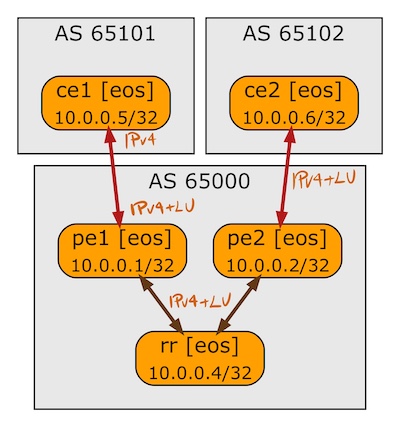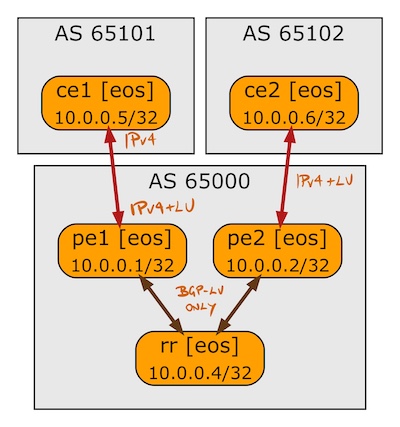BGP Labeled Unicast on Arista EOS
A week ago I described how Cisco IOS implemented BGP Labeled Unicast. In this blog post we’ll focus on Arista EOS using the same lab as before:

BGP sessions in the BGP-LU lab
Arista EOS treats Labeled Unicast as a completely separate address family:
pe1#show run sect bgp
router bgp 65000
router-id 10.0.0.1
bgp advertise-inactive
neighbor 10.0.0.4 remote-as 65000
neighbor 10.0.0.4 next-hop-self
neighbor 10.0.0.4 update-source Loopback0
neighbor 10.0.0.4 description rr
neighbor 10.0.0.4 send-community standard extended
neighbor 10.1.0.1 remote-as 65101
neighbor 10.1.0.1 description ce1
neighbor 10.1.0.1 send-community standard
!
address-family ipv4
neighbor 10.0.0.4 activate
neighbor 10.1.0.1 activate
network 10.0.0.1/32
!
address-family ipv4 labeled-unicast
neighbor 10.0.0.4 activate
neighbor 10.1.0.1 activate
network 10.0.0.1/32
An IP prefix can be advertised with or without a label, but it has to be listed in a network statement in the corresponding address family (or redistributed into it).
While it looks like BGP routing processes on Arista EOS store labeled and unlabeled prefixes in the same BGP RIB (at least according to the show ip bgp printouts), the RIB contains two copies of the same prefix if they were advertised over the two address families.
For example, the RIB table on PE1 contains two copies of all IPv4 prefixes advertised in our lab apart from the prefix advertised by CE1 which does not use IPv4 Labeled Unicast.
pe1#show ip bgp
BGP routing table information for VRF default
Router identifier 10.0.0.1, local AS number 65000
Route status codes: s - suppressed, * - valid, > - active, E - ECMP head, e - ECMP
S - Stale, c - Contributing to ECMP, b - backup, L - labeled-unicast
% - Pending BGP convergence
Origin codes: i - IGP, e - EGP, ? - incomplete
RPKI Origin Validation codes: V - valid, I - invalid, U - unknown
AS Path Attributes: Or-ID - Originator ID, C-LST - Cluster List, LL Nexthop - Link Local Nexthop
Network Next Hop Metric AIGP LocPref Weight Path
* > 10.0.0.1/32 - - - - 0 i
* > L 10.0.0.1/32 - - - - 0 i
* > 10.0.0.2/32 10.0.0.2 0 - 100 0 i Or-ID: 10.0.0.2 C-LST: 10.0.0.4
* > L 10.0.0.2/32 10.0.0.2 0 - 100 0 i Or-ID: 10.0.0.2 C-LST: 10.0.0.4
* > 10.0.0.4/32 10.0.0.4 0 - 100 0 i
* > L 10.0.0.4/32 10.0.0.4 0 - 100 0 i
* > 10.0.0.5/32 10.1.0.1 0 - 100 0 65101 i
* > 10.0.0.6/32 10.0.0.2 0 - 100 0 65102 i Or-ID: 10.0.0.2 C-LST: 10.0.0.4
* > L 10.0.0.6/32 10.0.0.2 0 - 100 0 65102 i Or-ID: 10.0.0.2 C-LST: 10.0.0.4
Looking at an individual prefix, you’ll notice that both copies are the best routes (in their corresponding address families):
pe1#show ip bgp 10.0.0.6
BGP routing table information for VRF default
Router identifier 10.0.0.1, local AS number 65000
BGP routing table entry for 10.0.0.6/32
Paths: 2 available
65102
10.0.0.2 from 10.0.0.4 (10.0.0.4)
Origin IGP, metric 0, localpref 100, IGP metric 30, weight 0, tag 0
Received 01:36:01 ago, valid, internal, best
Originator: 10.0.0.2, Cluster list: 10.0.0.4
Rx SAFI: Unicast
Tunnel RIB eligible
65102
10.0.0.2 labels [ 100000 ] from 10.0.0.4 (10.0.0.4)
Origin IGP, metric 0, localpref 100, IGP metric 30, weight 0, tag 0
Received 01:35:57 ago, valid, internal, best
Originator: 10.0.0.2, Cluster list: 10.0.0.4
Local MPLS label: 100001
Rx SAFI: MplsLabel
Tunnel RIB eligible
Even more interesting, Arista EOS does not enter the labeled unicast prefixes into the IP routing table by default. After deactivating the neighbors in the IPv4 address family on the route reflector (turning the central AS into BGP-LU-only AS), the routing table on PE2 no longer contains the BGP route for CE1.

Route reflector in AS6500 propagates only BGP-LU prefixes
pe2#show ip bgp
...
Network Next Hop Metric AIGP LocPref Weight Path
* > L 10.0.0.1/32 10.0.0.1 0 - 100 0 i Or-ID: 10.0.0.1 C-LST: 10.0.0.4
* > 10.0.0.2/32 - - - - 0 i
* > L 10.0.0.2/32 - - - - 0 i
* > L 10.0.0.4/32 10.0.0.4 0 - 100 0 i
* > 10.0.0.6/32 10.1.0.5 0 - 100 0 65102 i
* > L 10.0.0.6/32 10.1.0.5 0 - 100 0 65102 i
pe2#show ip route bgp
...
B E 10.0.0.6/32 [200/0] via 10.1.0.5, Ethernet1
You have to configure bgp labeled-unicast rib ip within the BGP routing process to use labeled unicast prefixes for IP forwarding. Doing that on PE1 brings the BGP prefix for CE2 into the routing table, including the label stack built from BGP-LU and LDP labels:
pe1#show ip bgp
BGP routing table information for VRF default
...
Network Next Hop Metric AIGP LocPref Weight Path
* > 10.0.0.1/32 - - - - 0 i
* > L 10.0.0.1/32 - - - - 0 i
* > L 10.0.0.2/32 10.0.0.2 0 - 100 0 i Or-ID: 10.0.0.2 C-LST: 10.0.0.4
* > L 10.0.0.4/32 10.0.0.4 0 - 100 0 i
* > 10.0.0.5/32 10.1.0.1 0 - 100 0 65101 i
* > L 10.0.0.6/32 10.0.0.2 0 - 100 0 65102 i Or-ID: 10.0.0.2 C-LST: 10.0.0.4
pe1#show ip route bgp
...
B E 10.0.0.5/32 [200/0] via 10.1.0.1, Ethernet1
B I 10.0.0.6/32 [200/0] via BGP LU Push tunnel index 23
via LDP tunnel index 2, label 100000
via 10.1.0.9, Ethernet2, label 116385
The bgp labeled-unicast rib ip nerd knob solves the IP forwarding challenges on PE1, but we’re still missing the BGP prefix for CE1 on PE2 – CE1 advertises its prefix only over IPv4 AF and that advertisement never gets across IPv4-LU-only route reflector.
I couldn’t find a way to import routes from IPv4 address family into IPv4 Labeled Unicast address family, so it looks like we have these design options:
- Use BGP-LU to distribute next hop labels for other services (Inter-AS MPLS/VPN Option C typically uses this approach as does SR-MPLS-over-BGP). IPv4-LU/IPv6-LU address families are totally independent from the IPv4/IPv6 address families and are not used for IP forwarding.
- Use BGP-LU to distribute BGP prefixes that can be used for IP forwarding. Labeled prefixes are preferred over unlabeled ones, but you SHOULD run labeled- and unlabeled address families in parallel in a non-homogeneous environment to ensure at least one of them has a usable prefix.
Have I missed something? Please write a comment!
Summary: Arista EOS
- Labeled unicast is configured as an independent address family. BGP neighbors have to be activated within the ipv4 labeled-unicast or ipv6 labeled-unicast address family.
- BGP prefixes must be originated within ipv4/ipv6 and/or ipv4 labeled-unicast/ipv6 labeled-unicast address families. Unlabeled BGP prefixes cannot be imported into labeled address family or vice versa. Routes redistributed into BGP are not redistributed into labeled-unicast address families1.
- Separate updates are sent for labeled and unlabeled prefixes.
- Labeled prefixes are not inserted into the IP routing- and forwarding tables unless you configure bgp labeled-unicast rib ip within the BGP routing process.
-
Or I missed another nerd knob, in which case please write a comment and I’ll fix the blog post. ↩︎
